Research Proposal: Work Related Fatigue of Nurses, University Hospital
VerifiedAdded on 2021/10/04
|15
|3207
|77
Report
AI Summary
This research proposal investigates work-related fatigue among nurses at University Hospital in Jordan. The study aims to identify the causes of fatigue, assess the effectiveness of a risk management system in reducing stress, and improve patient safety. Employing a quantitative cross-sectional analysis, the research will examine the relationship between fatigue and the working environment. The proposal includes a literature review highlighting the impact of fatigue on nurses' performance and patient outcomes. The methodology section details the research design, sample, measurement techniques, data collection plan, and ethical considerations. The expected outcome is a reduction in nurse fatigue through the implementation of a risk management system, leading to enhanced patient safety. The study acknowledges potential limitations and provides appendices including a survey questionnaire.
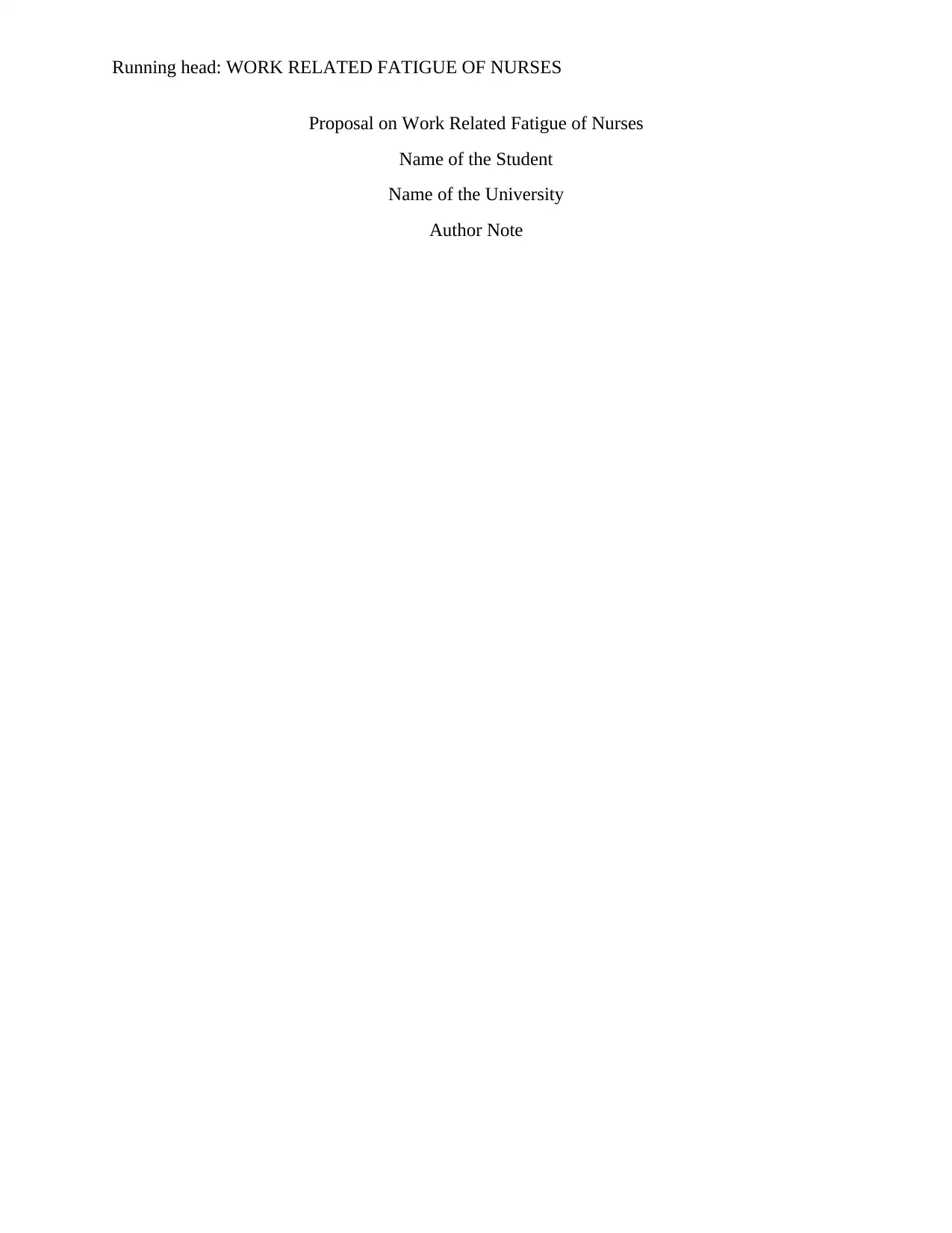
Running head: WORK RELATED FATIGUE OF NURSES
Proposal on Work Related Fatigue of Nurses
Name of the Student
Name of the University
Author Note
Proposal on Work Related Fatigue of Nurses
Name of the Student
Name of the University
Author Note
Paraphrase This Document
Need a fresh take? Get an instant paraphrase of this document with our AI Paraphraser
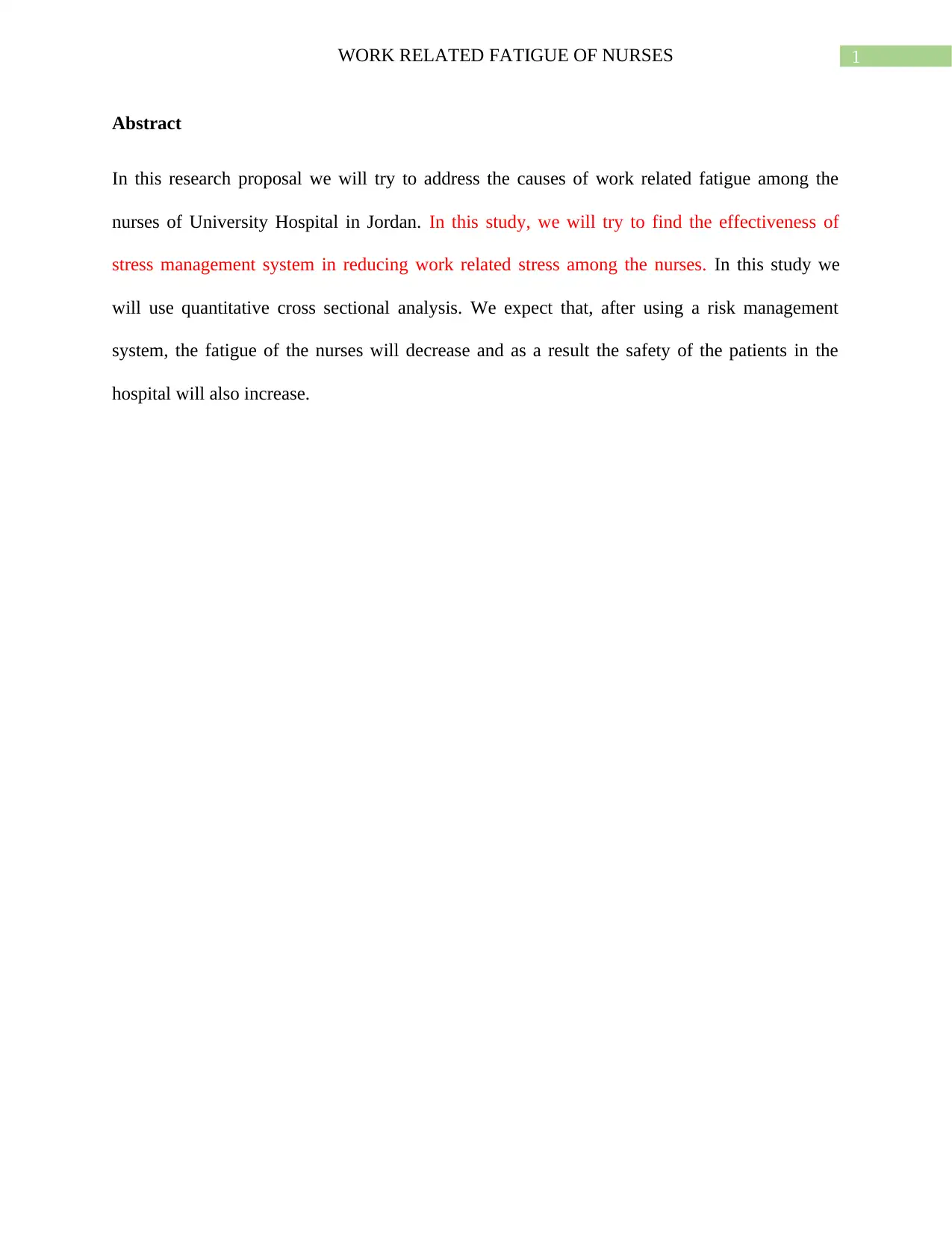
1WORK RELATED FATIGUE OF NURSES
Abstract
In this research proposal we will try to address the causes of work related fatigue among the
nurses of University Hospital in Jordan. In this study, we will try to find the effectiveness of
stress management system in reducing work related stress among the nurses. In this study we
will use quantitative cross sectional analysis. We expect that, after using a risk management
system, the fatigue of the nurses will decrease and as a result the safety of the patients in the
hospital will also increase.
Abstract
In this research proposal we will try to address the causes of work related fatigue among the
nurses of University Hospital in Jordan. In this study, we will try to find the effectiveness of
stress management system in reducing work related stress among the nurses. In this study we
will use quantitative cross sectional analysis. We expect that, after using a risk management
system, the fatigue of the nurses will decrease and as a result the safety of the patients in the
hospital will also increase.
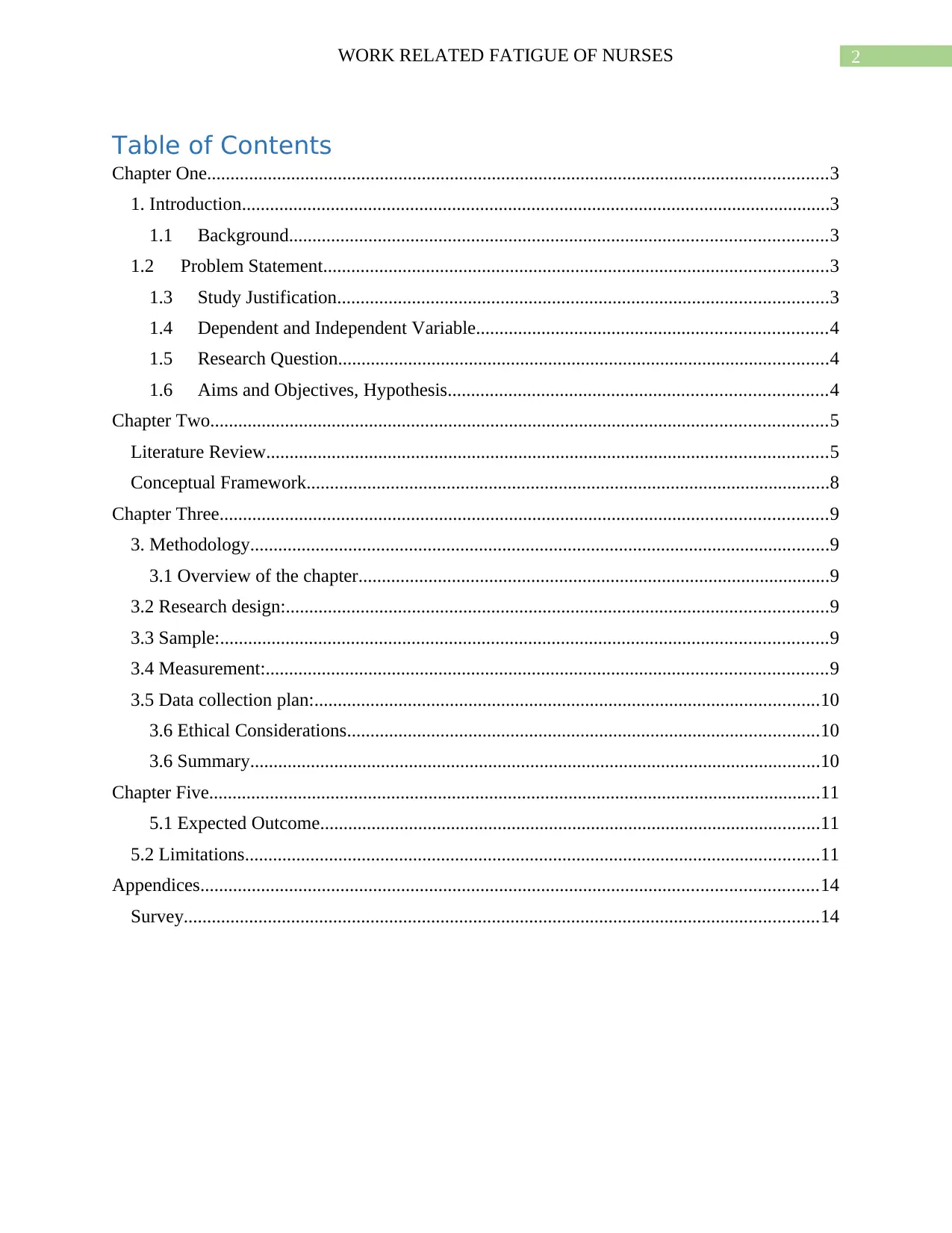
2WORK RELATED FATIGUE OF NURSES
Table of Contents
Chapter One.....................................................................................................................................3
1. Introduction..............................................................................................................................3
1.1 Background...................................................................................................................3
1.2 Problem Statement............................................................................................................3
1.3 Study Justification.........................................................................................................3
1.4 Dependent and Independent Variable...........................................................................4
1.5 Research Question.........................................................................................................4
1.6 Aims and Objectives, Hypothesis.................................................................................4
Chapter Two....................................................................................................................................5
Literature Review........................................................................................................................5
Conceptual Framework................................................................................................................8
Chapter Three..................................................................................................................................9
3. Methodology............................................................................................................................9
3.1 Overview of the chapter.....................................................................................................9
3.2 Research design:....................................................................................................................9
3.3 Sample:..................................................................................................................................9
3.4 Measurement:........................................................................................................................9
3.5 Data collection plan:............................................................................................................10
3.6 Ethical Considerations.....................................................................................................10
3.6 Summary..........................................................................................................................10
Chapter Five...................................................................................................................................11
5.1 Expected Outcome...........................................................................................................11
5.2 Limitations...........................................................................................................................11
Appendices....................................................................................................................................14
Survey........................................................................................................................................14
Table of Contents
Chapter One.....................................................................................................................................3
1. Introduction..............................................................................................................................3
1.1 Background...................................................................................................................3
1.2 Problem Statement............................................................................................................3
1.3 Study Justification.........................................................................................................3
1.4 Dependent and Independent Variable...........................................................................4
1.5 Research Question.........................................................................................................4
1.6 Aims and Objectives, Hypothesis.................................................................................4
Chapter Two....................................................................................................................................5
Literature Review........................................................................................................................5
Conceptual Framework................................................................................................................8
Chapter Three..................................................................................................................................9
3. Methodology............................................................................................................................9
3.1 Overview of the chapter.....................................................................................................9
3.2 Research design:....................................................................................................................9
3.3 Sample:..................................................................................................................................9
3.4 Measurement:........................................................................................................................9
3.5 Data collection plan:............................................................................................................10
3.6 Ethical Considerations.....................................................................................................10
3.6 Summary..........................................................................................................................10
Chapter Five...................................................................................................................................11
5.1 Expected Outcome...........................................................................................................11
5.2 Limitations...........................................................................................................................11
Appendices....................................................................................................................................14
Survey........................................................................................................................................14
⊘ This is a preview!⊘
Do you want full access?
Subscribe today to unlock all pages.

Trusted by 1+ million students worldwide
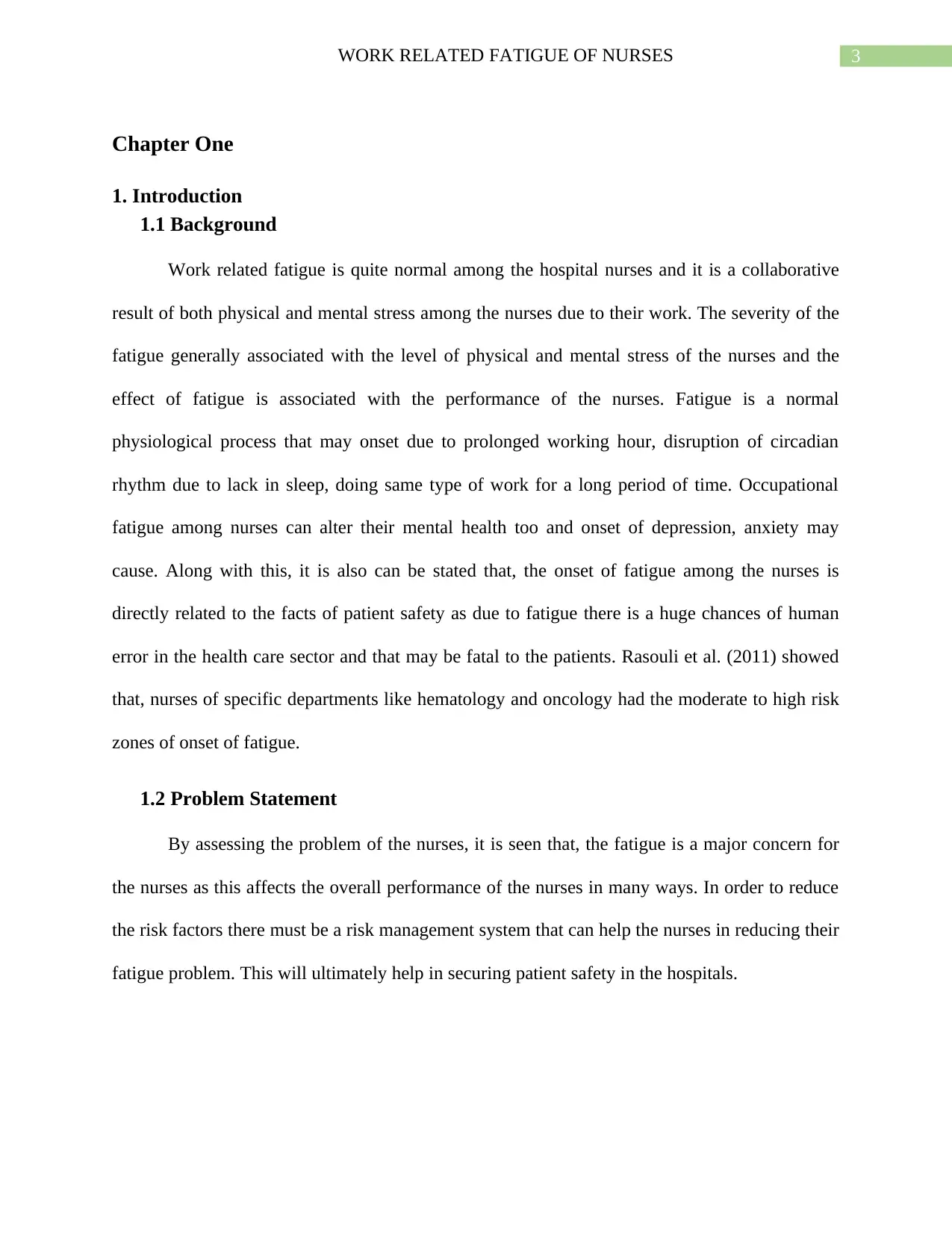
3WORK RELATED FATIGUE OF NURSES
Chapter One
1. Introduction
1.1 Background
Work related fatigue is quite normal among the hospital nurses and it is a collaborative
result of both physical and mental stress among the nurses due to their work. The severity of the
fatigue generally associated with the level of physical and mental stress of the nurses and the
effect of fatigue is associated with the performance of the nurses. Fatigue is a normal
physiological process that may onset due to prolonged working hour, disruption of circadian
rhythm due to lack in sleep, doing same type of work for a long period of time. Occupational
fatigue among nurses can alter their mental health too and onset of depression, anxiety may
cause. Along with this, it is also can be stated that, the onset of fatigue among the nurses is
directly related to the facts of patient safety as due to fatigue there is a huge chances of human
error in the health care sector and that may be fatal to the patients. Rasouli et al. (2011) showed
that, nurses of specific departments like hematology and oncology had the moderate to high risk
zones of onset of fatigue.
1.2 Problem Statement
By assessing the problem of the nurses, it is seen that, the fatigue is a major concern for
the nurses as this affects the overall performance of the nurses in many ways. In order to reduce
the risk factors there must be a risk management system that can help the nurses in reducing their
fatigue problem. This will ultimately help in securing patient safety in the hospitals.
Chapter One
1. Introduction
1.1 Background
Work related fatigue is quite normal among the hospital nurses and it is a collaborative
result of both physical and mental stress among the nurses due to their work. The severity of the
fatigue generally associated with the level of physical and mental stress of the nurses and the
effect of fatigue is associated with the performance of the nurses. Fatigue is a normal
physiological process that may onset due to prolonged working hour, disruption of circadian
rhythm due to lack in sleep, doing same type of work for a long period of time. Occupational
fatigue among nurses can alter their mental health too and onset of depression, anxiety may
cause. Along with this, it is also can be stated that, the onset of fatigue among the nurses is
directly related to the facts of patient safety as due to fatigue there is a huge chances of human
error in the health care sector and that may be fatal to the patients. Rasouli et al. (2011) showed
that, nurses of specific departments like hematology and oncology had the moderate to high risk
zones of onset of fatigue.
1.2 Problem Statement
By assessing the problem of the nurses, it is seen that, the fatigue is a major concern for
the nurses as this affects the overall performance of the nurses in many ways. In order to reduce
the risk factors there must be a risk management system that can help the nurses in reducing their
fatigue problem. This will ultimately help in securing patient safety in the hospitals.
Paraphrase This Document
Need a fresh take? Get an instant paraphrase of this document with our AI Paraphraser
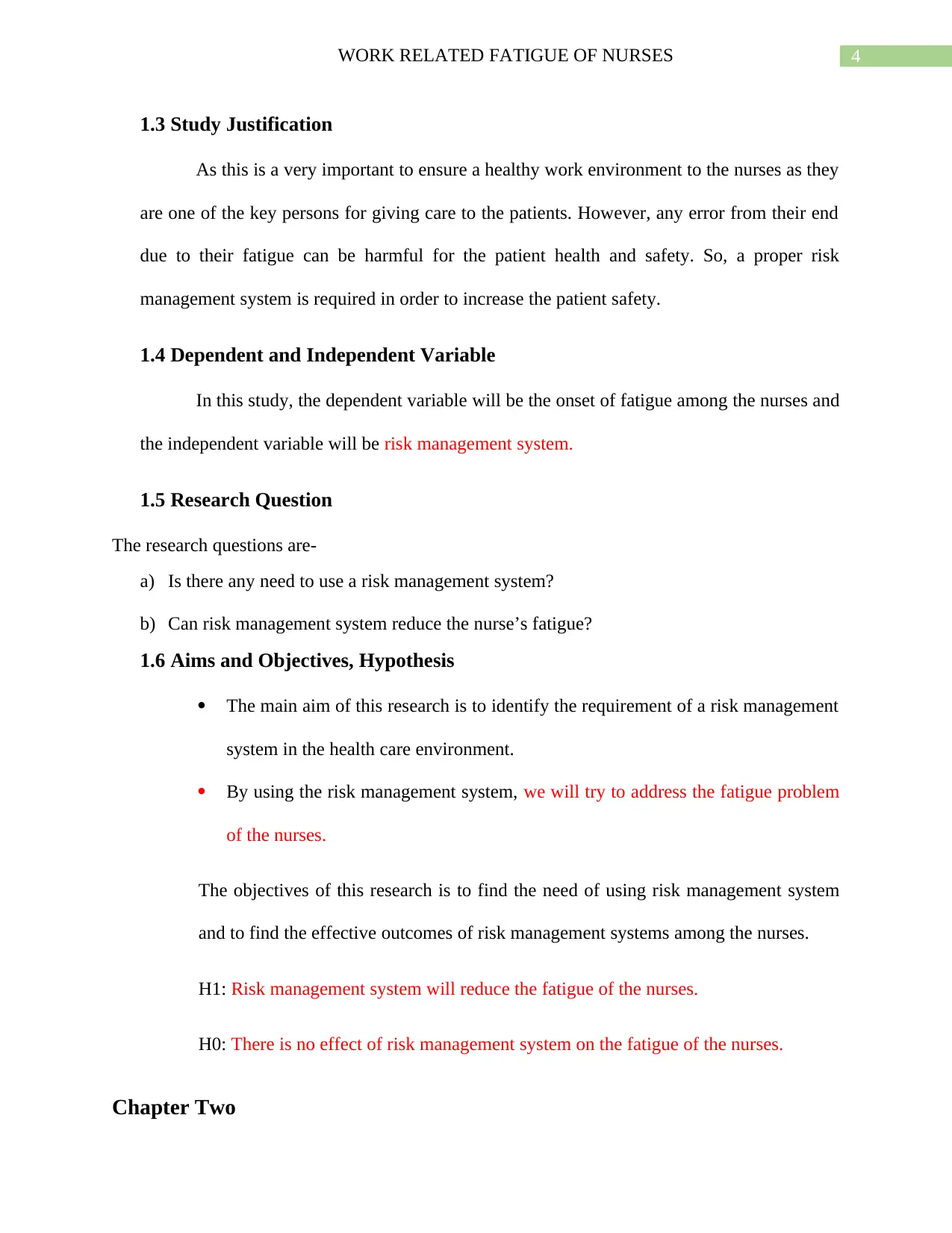
4WORK RELATED FATIGUE OF NURSES
1.3 Study Justification
As this is a very important to ensure a healthy work environment to the nurses as they
are one of the key persons for giving care to the patients. However, any error from their end
due to their fatigue can be harmful for the patient health and safety. So, a proper risk
management system is required in order to increase the patient safety.
1.4 Dependent and Independent Variable
In this study, the dependent variable will be the onset of fatigue among the nurses and
the independent variable will be risk management system.
1.5 Research Question
The research questions are-
a) Is there any need to use a risk management system?
b) Can risk management system reduce the nurse’s fatigue?
1.6 Aims and Objectives, Hypothesis
The main aim of this research is to identify the requirement of a risk management
system in the health care environment.
By using the risk management system, we will try to address the fatigue problem
of the nurses.
The objectives of this research is to find the need of using risk management system
and to find the effective outcomes of risk management systems among the nurses.
H1: Risk management system will reduce the fatigue of the nurses.
H0: There is no effect of risk management system on the fatigue of the nurses.
Chapter Two
1.3 Study Justification
As this is a very important to ensure a healthy work environment to the nurses as they
are one of the key persons for giving care to the patients. However, any error from their end
due to their fatigue can be harmful for the patient health and safety. So, a proper risk
management system is required in order to increase the patient safety.
1.4 Dependent and Independent Variable
In this study, the dependent variable will be the onset of fatigue among the nurses and
the independent variable will be risk management system.
1.5 Research Question
The research questions are-
a) Is there any need to use a risk management system?
b) Can risk management system reduce the nurse’s fatigue?
1.6 Aims and Objectives, Hypothesis
The main aim of this research is to identify the requirement of a risk management
system in the health care environment.
By using the risk management system, we will try to address the fatigue problem
of the nurses.
The objectives of this research is to find the need of using risk management system
and to find the effective outcomes of risk management systems among the nurses.
H1: Risk management system will reduce the fatigue of the nurses.
H0: There is no effect of risk management system on the fatigue of the nurses.
Chapter Two
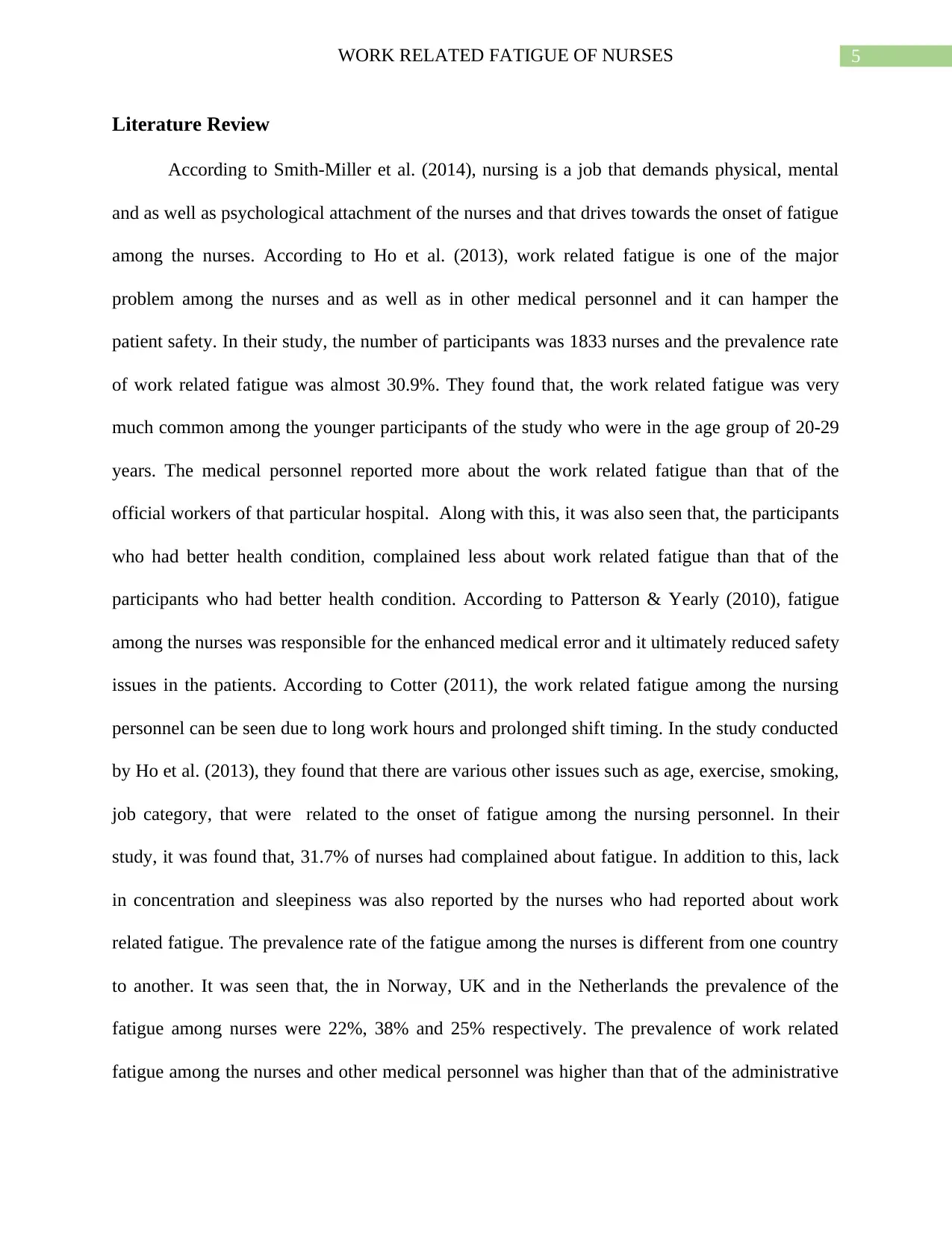
5WORK RELATED FATIGUE OF NURSES
Literature Review
According to Smith-Miller et al. (2014), nursing is a job that demands physical, mental
and as well as psychological attachment of the nurses and that drives towards the onset of fatigue
among the nurses. According to Ho et al. (2013), work related fatigue is one of the major
problem among the nurses and as well as in other medical personnel and it can hamper the
patient safety. In their study, the number of participants was 1833 nurses and the prevalence rate
of work related fatigue was almost 30.9%. They found that, the work related fatigue was very
much common among the younger participants of the study who were in the age group of 20-29
years. The medical personnel reported more about the work related fatigue than that of the
official workers of that particular hospital. Along with this, it was also seen that, the participants
who had better health condition, complained less about work related fatigue than that of the
participants who had better health condition. According to Patterson & Yearly (2010), fatigue
among the nurses was responsible for the enhanced medical error and it ultimately reduced safety
issues in the patients. According to Cotter (2011), the work related fatigue among the nursing
personnel can be seen due to long work hours and prolonged shift timing. In the study conducted
by Ho et al. (2013), they found that there are various other issues such as age, exercise, smoking,
job category, that were related to the onset of fatigue among the nursing personnel. In their
study, it was found that, 31.7% of nurses had complained about fatigue. In addition to this, lack
in concentration and sleepiness was also reported by the nurses who had reported about work
related fatigue. The prevalence rate of the fatigue among the nurses is different from one country
to another. It was seen that, the in Norway, UK and in the Netherlands the prevalence of the
fatigue among nurses were 22%, 38% and 25% respectively. The prevalence of work related
fatigue among the nurses and other medical personnel was higher than that of the administrative
Literature Review
According to Smith-Miller et al. (2014), nursing is a job that demands physical, mental
and as well as psychological attachment of the nurses and that drives towards the onset of fatigue
among the nurses. According to Ho et al. (2013), work related fatigue is one of the major
problem among the nurses and as well as in other medical personnel and it can hamper the
patient safety. In their study, the number of participants was 1833 nurses and the prevalence rate
of work related fatigue was almost 30.9%. They found that, the work related fatigue was very
much common among the younger participants of the study who were in the age group of 20-29
years. The medical personnel reported more about the work related fatigue than that of the
official workers of that particular hospital. Along with this, it was also seen that, the participants
who had better health condition, complained less about work related fatigue than that of the
participants who had better health condition. According to Patterson & Yearly (2010), fatigue
among the nurses was responsible for the enhanced medical error and it ultimately reduced safety
issues in the patients. According to Cotter (2011), the work related fatigue among the nursing
personnel can be seen due to long work hours and prolonged shift timing. In the study conducted
by Ho et al. (2013), they found that there are various other issues such as age, exercise, smoking,
job category, that were related to the onset of fatigue among the nursing personnel. In their
study, it was found that, 31.7% of nurses had complained about fatigue. In addition to this, lack
in concentration and sleepiness was also reported by the nurses who had reported about work
related fatigue. The prevalence rate of the fatigue among the nurses is different from one country
to another. It was seen that, the in Norway, UK and in the Netherlands the prevalence of the
fatigue among nurses were 22%, 38% and 25% respectively. The prevalence of work related
fatigue among the nurses and other medical personnel was higher than that of the administrative
⊘ This is a preview!⊘
Do you want full access?
Subscribe today to unlock all pages.

Trusted by 1+ million students worldwide
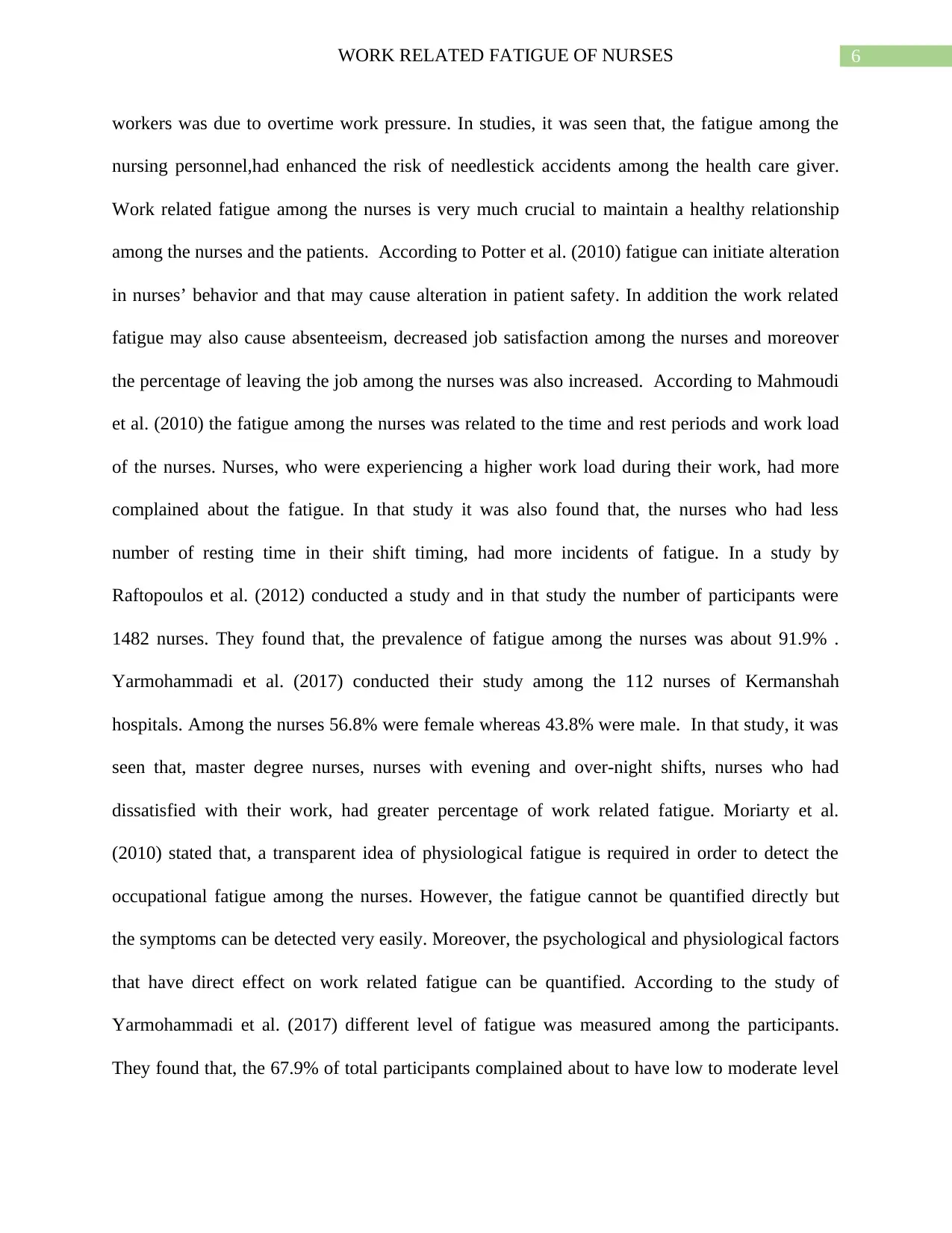
6WORK RELATED FATIGUE OF NURSES
workers was due to overtime work pressure. In studies, it was seen that, the fatigue among the
nursing personnel,had enhanced the risk of needlestick accidents among the health care giver.
Work related fatigue among the nurses is very much crucial to maintain a healthy relationship
among the nurses and the patients. According to Potter et al. (2010) fatigue can initiate alteration
in nurses’ behavior and that may cause alteration in patient safety. In addition the work related
fatigue may also cause absenteeism, decreased job satisfaction among the nurses and moreover
the percentage of leaving the job among the nurses was also increased. According to Mahmoudi
et al. (2010) the fatigue among the nurses was related to the time and rest periods and work load
of the nurses. Nurses, who were experiencing a higher work load during their work, had more
complained about the fatigue. In that study it was also found that, the nurses who had less
number of resting time in their shift timing, had more incidents of fatigue. In a study by
Raftopoulos et al. (2012) conducted a study and in that study the number of participants were
1482 nurses. They found that, the prevalence of fatigue among the nurses was about 91.9% .
Yarmohammadi et al. (2017) conducted their study among the 112 nurses of Kermanshah
hospitals. Among the nurses 56.8% were female whereas 43.8% were male. In that study, it was
seen that, master degree nurses, nurses with evening and over-night shifts, nurses who had
dissatisfied with their work, had greater percentage of work related fatigue. Moriarty et al.
(2010) stated that, a transparent idea of physiological fatigue is required in order to detect the
occupational fatigue among the nurses. However, the fatigue cannot be quantified directly but
the symptoms can be detected very easily. Moreover, the psychological and physiological factors
that have direct effect on work related fatigue can be quantified. According to the study of
Yarmohammadi et al. (2017) different level of fatigue was measured among the participants.
They found that, the 67.9% of total participants complained about to have low to moderate level
workers was due to overtime work pressure. In studies, it was seen that, the fatigue among the
nursing personnel,had enhanced the risk of needlestick accidents among the health care giver.
Work related fatigue among the nurses is very much crucial to maintain a healthy relationship
among the nurses and the patients. According to Potter et al. (2010) fatigue can initiate alteration
in nurses’ behavior and that may cause alteration in patient safety. In addition the work related
fatigue may also cause absenteeism, decreased job satisfaction among the nurses and moreover
the percentage of leaving the job among the nurses was also increased. According to Mahmoudi
et al. (2010) the fatigue among the nurses was related to the time and rest periods and work load
of the nurses. Nurses, who were experiencing a higher work load during their work, had more
complained about the fatigue. In that study it was also found that, the nurses who had less
number of resting time in their shift timing, had more incidents of fatigue. In a study by
Raftopoulos et al. (2012) conducted a study and in that study the number of participants were
1482 nurses. They found that, the prevalence of fatigue among the nurses was about 91.9% .
Yarmohammadi et al. (2017) conducted their study among the 112 nurses of Kermanshah
hospitals. Among the nurses 56.8% were female whereas 43.8% were male. In that study, it was
seen that, master degree nurses, nurses with evening and over-night shifts, nurses who had
dissatisfied with their work, had greater percentage of work related fatigue. Moriarty et al.
(2010) stated that, a transparent idea of physiological fatigue is required in order to detect the
occupational fatigue among the nurses. However, the fatigue cannot be quantified directly but
the symptoms can be detected very easily. Moreover, the psychological and physiological factors
that have direct effect on work related fatigue can be quantified. According to the study of
Yarmohammadi et al. (2017) different level of fatigue was measured among the participants.
They found that, the 67.9% of total participants complained about to have low to moderate level
Paraphrase This Document
Need a fresh take? Get an instant paraphrase of this document with our AI Paraphraser
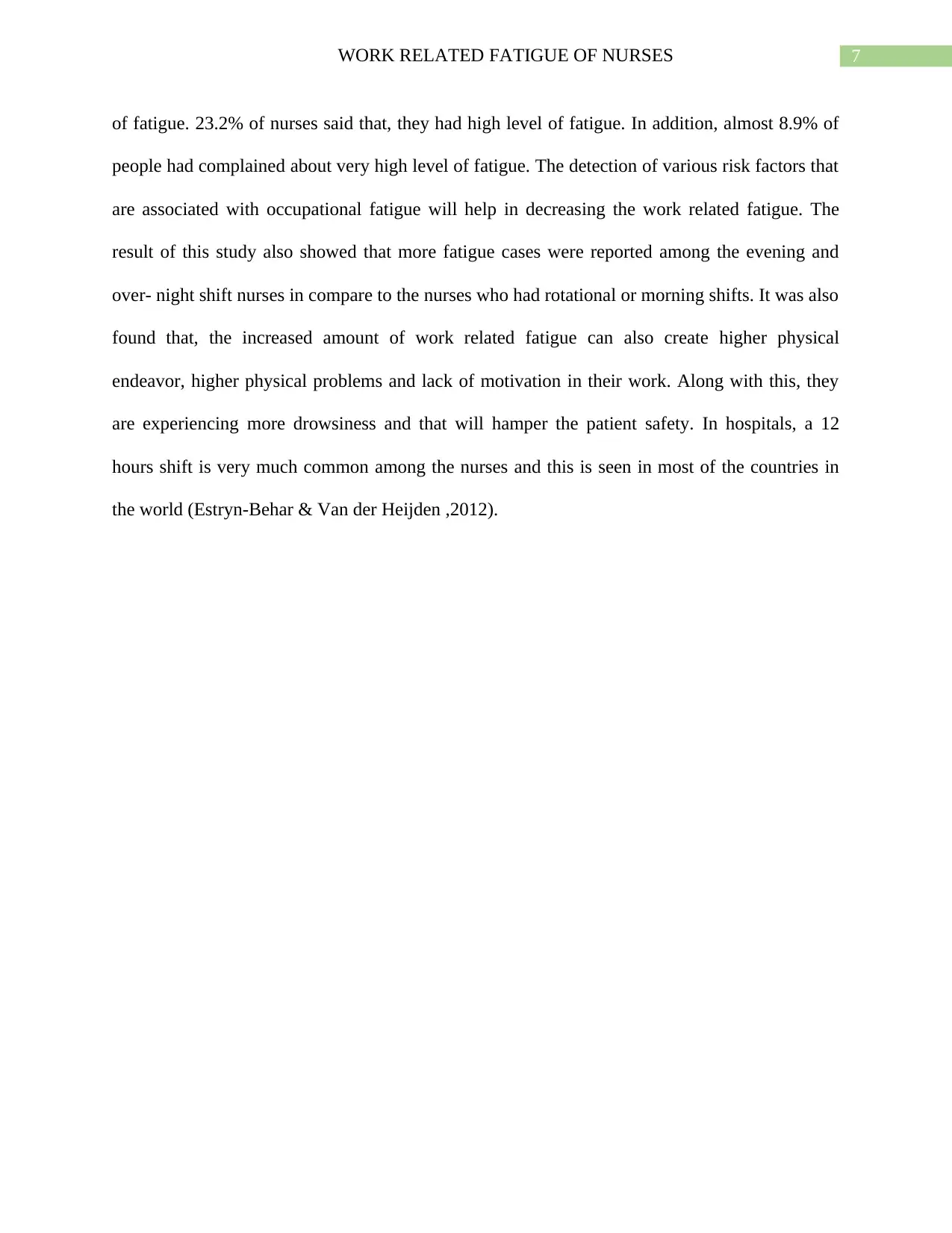
7WORK RELATED FATIGUE OF NURSES
of fatigue. 23.2% of nurses said that, they had high level of fatigue. In addition, almost 8.9% of
people had complained about very high level of fatigue. The detection of various risk factors that
are associated with occupational fatigue will help in decreasing the work related fatigue. The
result of this study also showed that more fatigue cases were reported among the evening and
over- night shift nurses in compare to the nurses who had rotational or morning shifts. It was also
found that, the increased amount of work related fatigue can also create higher physical
endeavor, higher physical problems and lack of motivation in their work. Along with this, they
are experiencing more drowsiness and that will hamper the patient safety. In hospitals, a 12
hours shift is very much common among the nurses and this is seen in most of the countries in
the world (Estryn-Behar & Van der Heijden ,2012).
of fatigue. 23.2% of nurses said that, they had high level of fatigue. In addition, almost 8.9% of
people had complained about very high level of fatigue. The detection of various risk factors that
are associated with occupational fatigue will help in decreasing the work related fatigue. The
result of this study also showed that more fatigue cases were reported among the evening and
over- night shift nurses in compare to the nurses who had rotational or morning shifts. It was also
found that, the increased amount of work related fatigue can also create higher physical
endeavor, higher physical problems and lack of motivation in their work. Along with this, they
are experiencing more drowsiness and that will hamper the patient safety. In hospitals, a 12
hours shift is very much common among the nurses and this is seen in most of the countries in
the world (Estryn-Behar & Van der Heijden ,2012).
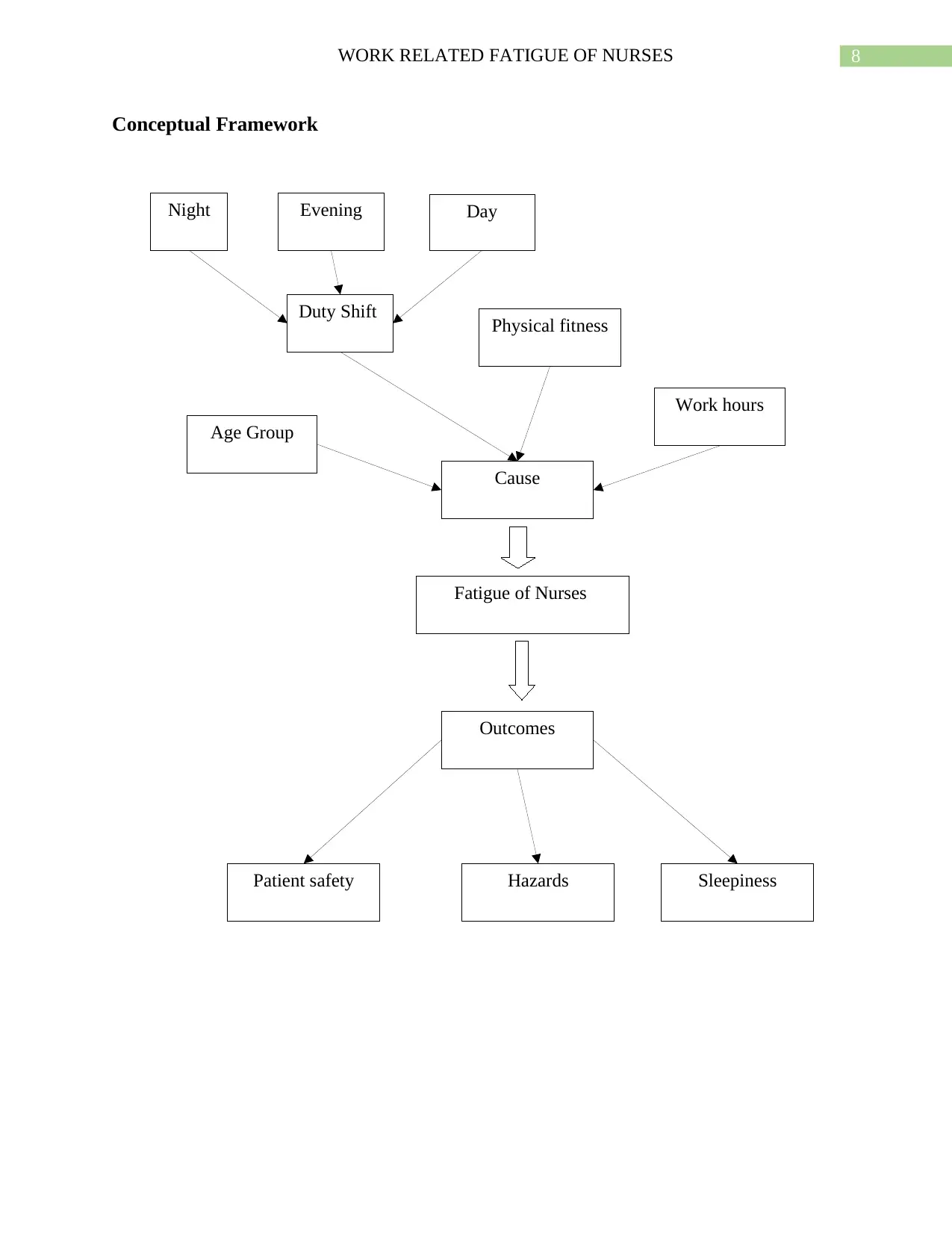
8WORK RELATED FATIGUE OF NURSES
Duty Shift
Night Evening Day
Age Group
Work hours
Fatigue of Nurses
Physical fitness
Outcomes
HazardsPatient safety Sleepiness
Cause
Conceptual Framework
Duty Shift
Night Evening Day
Age Group
Work hours
Fatigue of Nurses
Physical fitness
Outcomes
HazardsPatient safety Sleepiness
Cause
Conceptual Framework
⊘ This is a preview!⊘
Do you want full access?
Subscribe today to unlock all pages.

Trusted by 1+ million students worldwide
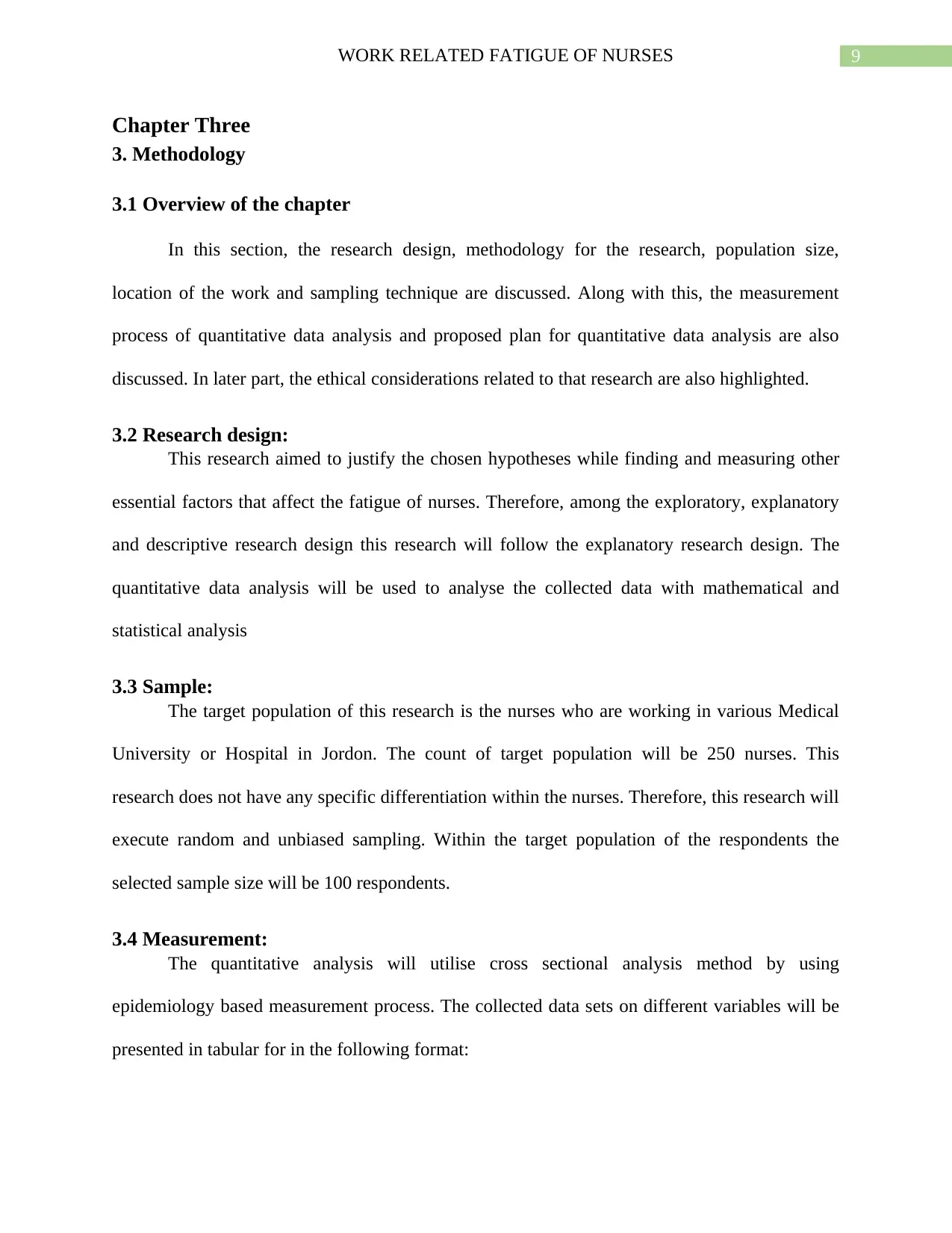
9WORK RELATED FATIGUE OF NURSES
Chapter Three
3. Methodology
3.1 Overview of the chapter
In this section, the research design, methodology for the research, population size,
location of the work and sampling technique are discussed. Along with this, the measurement
process of quantitative data analysis and proposed plan for quantitative data analysis are also
discussed. In later part, the ethical considerations related to that research are also highlighted.
3.2 Research design:
This research aimed to justify the chosen hypotheses while finding and measuring other
essential factors that affect the fatigue of nurses. Therefore, among the exploratory, explanatory
and descriptive research design this research will follow the explanatory research design. The
quantitative data analysis will be used to analyse the collected data with mathematical and
statistical analysis
3.3 Sample:
The target population of this research is the nurses who are working in various Medical
University or Hospital in Jordon. The count of target population will be 250 nurses. This
research does not have any specific differentiation within the nurses. Therefore, this research will
execute random and unbiased sampling. Within the target population of the respondents the
selected sample size will be 100 respondents.
3.4 Measurement:
The quantitative analysis will utilise cross sectional analysis method by using
epidemiology based measurement process. The collected data sets on different variables will be
presented in tabular for in the following format:
Chapter Three
3. Methodology
3.1 Overview of the chapter
In this section, the research design, methodology for the research, population size,
location of the work and sampling technique are discussed. Along with this, the measurement
process of quantitative data analysis and proposed plan for quantitative data analysis are also
discussed. In later part, the ethical considerations related to that research are also highlighted.
3.2 Research design:
This research aimed to justify the chosen hypotheses while finding and measuring other
essential factors that affect the fatigue of nurses. Therefore, among the exploratory, explanatory
and descriptive research design this research will follow the explanatory research design. The
quantitative data analysis will be used to analyse the collected data with mathematical and
statistical analysis
3.3 Sample:
The target population of this research is the nurses who are working in various Medical
University or Hospital in Jordon. The count of target population will be 250 nurses. This
research does not have any specific differentiation within the nurses. Therefore, this research will
execute random and unbiased sampling. Within the target population of the respondents the
selected sample size will be 100 respondents.
3.4 Measurement:
The quantitative analysis will utilise cross sectional analysis method by using
epidemiology based measurement process. The collected data sets on different variables will be
presented in tabular for in the following format:
Paraphrase This Document
Need a fresh take? Get an instant paraphrase of this document with our AI Paraphraser
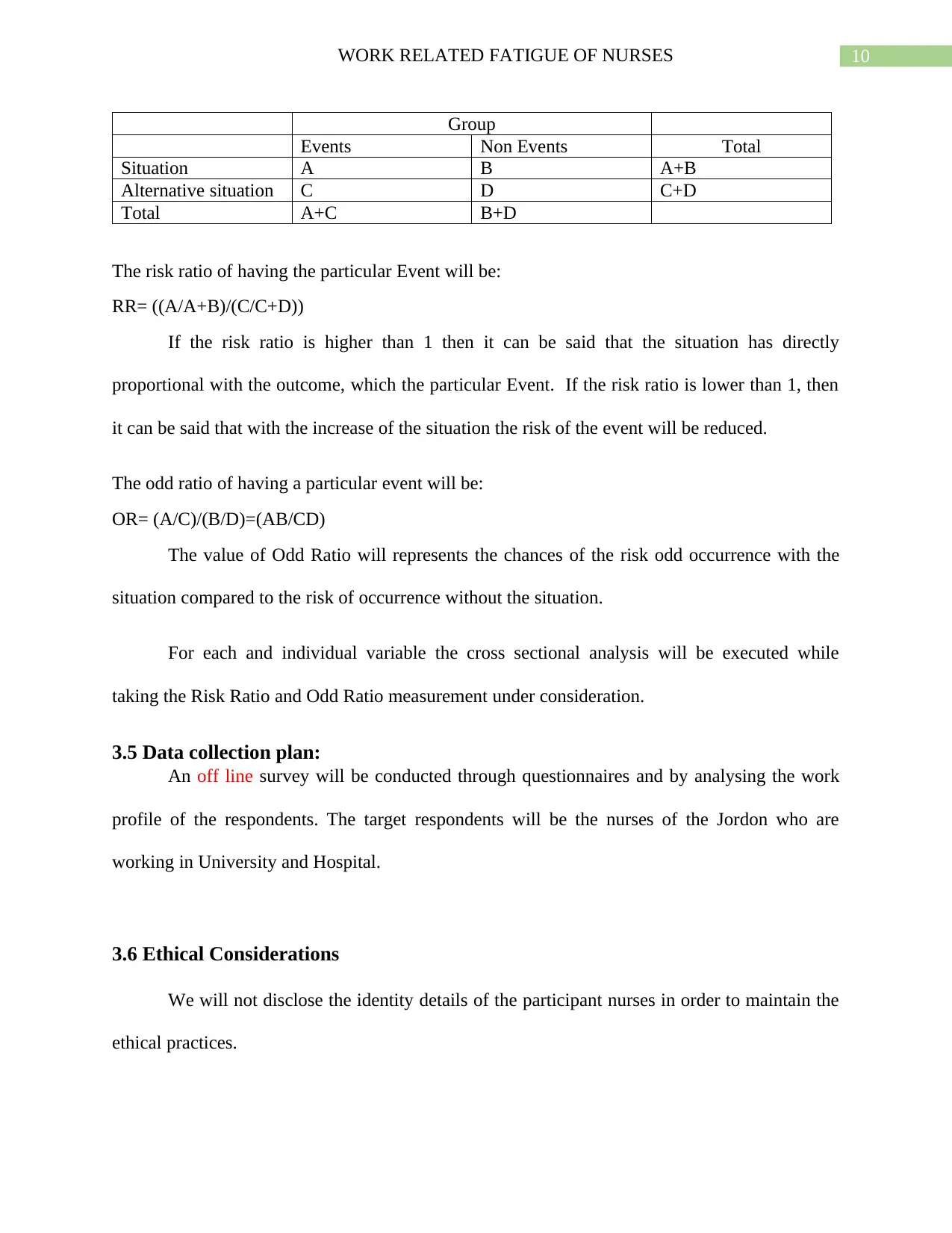
10WORK RELATED FATIGUE OF NURSES
Group
Events Non Events Total
Situation A B A+B
Alternative situation C D C+D
Total A+C B+D
The risk ratio of having the particular Event will be:
RR= ((A/A+B)/(C/C+D))
If the risk ratio is higher than 1 then it can be said that the situation has directly
proportional with the outcome, which the particular Event. If the risk ratio is lower than 1, then
it can be said that with the increase of the situation the risk of the event will be reduced.
The odd ratio of having a particular event will be:
OR= (A/C)/(B/D)=(AB/CD)
The value of Odd Ratio will represents the chances of the risk odd occurrence with the
situation compared to the risk of occurrence without the situation.
For each and individual variable the cross sectional analysis will be executed while
taking the Risk Ratio and Odd Ratio measurement under consideration.
3.5 Data collection plan:
An off line survey will be conducted through questionnaires and by analysing the work
profile of the respondents. The target respondents will be the nurses of the Jordon who are
working in University and Hospital.
3.6 Ethical Considerations
We will not disclose the identity details of the participant nurses in order to maintain the
ethical practices.
Group
Events Non Events Total
Situation A B A+B
Alternative situation C D C+D
Total A+C B+D
The risk ratio of having the particular Event will be:
RR= ((A/A+B)/(C/C+D))
If the risk ratio is higher than 1 then it can be said that the situation has directly
proportional with the outcome, which the particular Event. If the risk ratio is lower than 1, then
it can be said that with the increase of the situation the risk of the event will be reduced.
The odd ratio of having a particular event will be:
OR= (A/C)/(B/D)=(AB/CD)
The value of Odd Ratio will represents the chances of the risk odd occurrence with the
situation compared to the risk of occurrence without the situation.
For each and individual variable the cross sectional analysis will be executed while
taking the Risk Ratio and Odd Ratio measurement under consideration.
3.5 Data collection plan:
An off line survey will be conducted through questionnaires and by analysing the work
profile of the respondents. The target respondents will be the nurses of the Jordon who are
working in University and Hospital.
3.6 Ethical Considerations
We will not disclose the identity details of the participant nurses in order to maintain the
ethical practices.
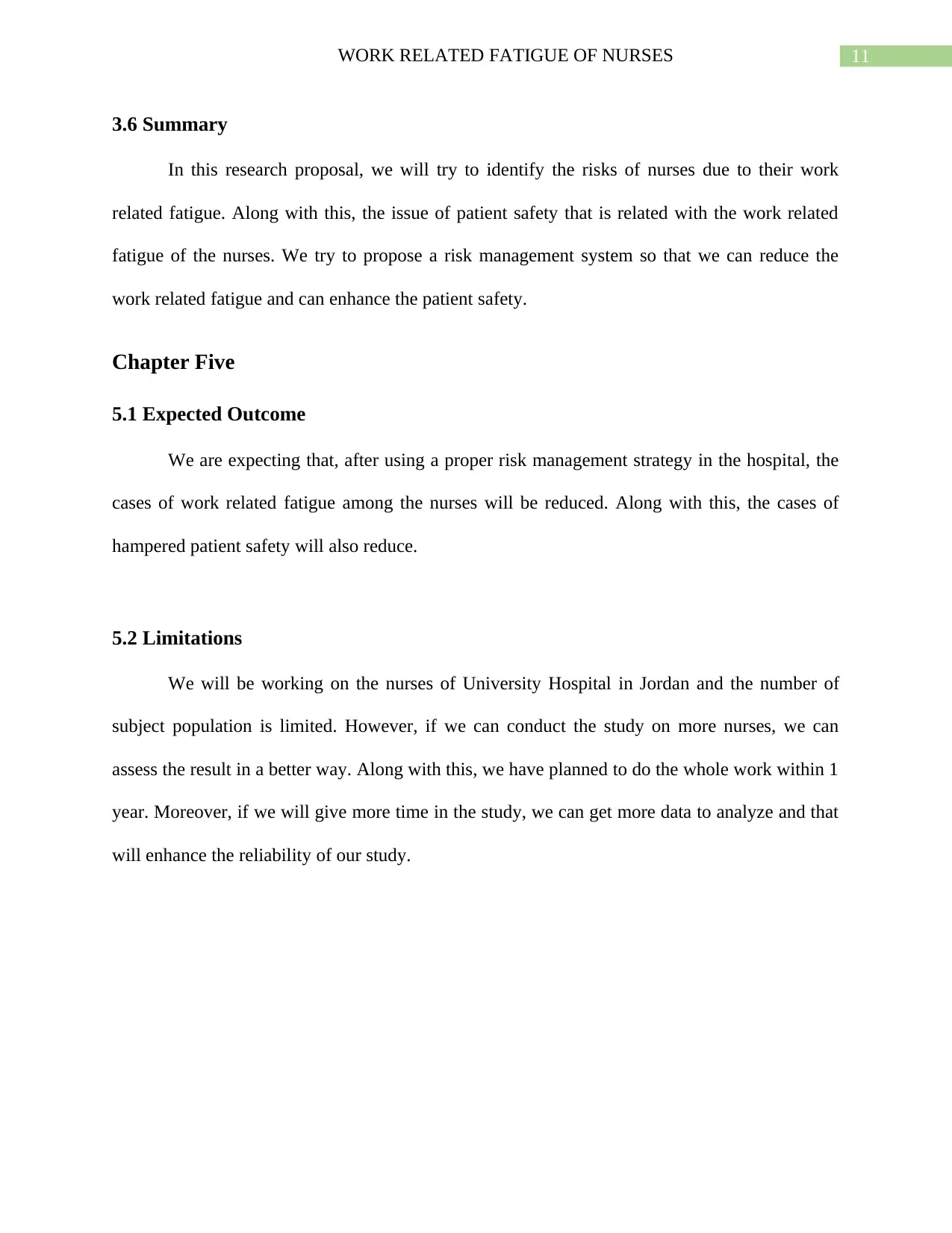
11WORK RELATED FATIGUE OF NURSES
3.6 Summary
In this research proposal, we will try to identify the risks of nurses due to their work
related fatigue. Along with this, the issue of patient safety that is related with the work related
fatigue of the nurses. We try to propose a risk management system so that we can reduce the
work related fatigue and can enhance the patient safety.
Chapter Five
5.1 Expected Outcome
We are expecting that, after using a proper risk management strategy in the hospital, the
cases of work related fatigue among the nurses will be reduced. Along with this, the cases of
hampered patient safety will also reduce.
5.2 Limitations
We will be working on the nurses of University Hospital in Jordan and the number of
subject population is limited. However, if we can conduct the study on more nurses, we can
assess the result in a better way. Along with this, we have planned to do the whole work within 1
year. Moreover, if we will give more time in the study, we can get more data to analyze and that
will enhance the reliability of our study.
3.6 Summary
In this research proposal, we will try to identify the risks of nurses due to their work
related fatigue. Along with this, the issue of patient safety that is related with the work related
fatigue of the nurses. We try to propose a risk management system so that we can reduce the
work related fatigue and can enhance the patient safety.
Chapter Five
5.1 Expected Outcome
We are expecting that, after using a proper risk management strategy in the hospital, the
cases of work related fatigue among the nurses will be reduced. Along with this, the cases of
hampered patient safety will also reduce.
5.2 Limitations
We will be working on the nurses of University Hospital in Jordan and the number of
subject population is limited. However, if we can conduct the study on more nurses, we can
assess the result in a better way. Along with this, we have planned to do the whole work within 1
year. Moreover, if we will give more time in the study, we can get more data to analyze and that
will enhance the reliability of our study.
⊘ This is a preview!⊘
Do you want full access?
Subscribe today to unlock all pages.

Trusted by 1+ million students worldwide
1 out of 15
Related Documents
Your All-in-One AI-Powered Toolkit for Academic Success.
+13062052269
info@desklib.com
Available 24*7 on WhatsApp / Email
![[object Object]](/_next/static/media/star-bottom.7253800d.svg)
Unlock your academic potential
Copyright © 2020–2025 A2Z Services. All Rights Reserved. Developed and managed by ZUCOL.





